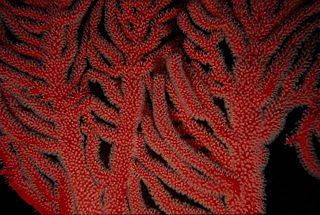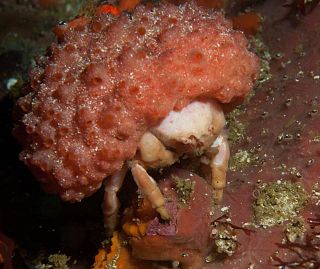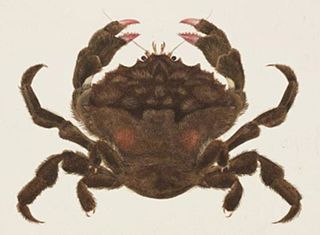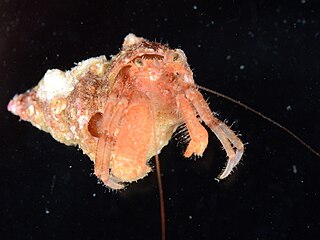
The Japanese spider crab is a species of marine crab and is the biggest one that lives in the waters around Japan. It has the largest known leg-span of any arthropod around 3.7 meters. The Japanese name for this species is taka-ashi-gani,, literally translating to “tall legs crab”. It goes through three main larval stages along with a prezoeal stage to grow to its great size.

Grapsus grapsus is one of the most common crabs along the western coast of the Americas. It is known as the red rock crab, or, along with other crabs such as Percnon gibbesi, as the Sally Lightfoot crab.

Notomithrax ursus, known as the hairy seaweed crab, is a spider crab of the family Majidae.

Dromia personata, also known as the sponge crab or sleepy crab, is a species of crab found in the North Sea, the Mediterranean Sea, and connecting parts of the northeastern Atlantic Ocean. Like most other epibenthic crustaceans, the biomass of this species is especially dense in the Mediterranean continental shelf. It mainly resides from the lower shore to a depth of 50 meters (164 ft), often in caves. Occasionally, they are found living in depths as low as 110 meters (360 ft). They serve as prey for octopus, starfish, and other fish. Their last two pairs of legs are positioned dorsally, and are used to hold a sponge in place as camouflage.

Dromia dormia, the sleepy sponge crab or common sponge crab, is the largest species of sponge crab. It grows to a carapace width of 20 cm (8 in) and lives in shallow waters across the Indo-Pacific region.

Achaeopsis spinulosa, the hotlips spider crab, is a species of crab in the family Inachidae, found only around the South African coast. It is the only species in the genus Achaeopsis.

Acanthonyx dentatus, the toothed decorator crab, is a species of crab in the family Inachidae.

Nemanthus annamensis, commonly known as the gorgonian wrapper, is a species of sea anemone found in central Indo-Pacific waters.
Suberites ficus is a species of sponge in the family Suberitidae. It is sometimes known as the fig sponge or orange sponge.

Serpula vermicularis, known by common names including the calcareous tubeworm, fan worm, plume worm or red tube worm, is a species of segmented marine polychaete worm in the family Serpulidae. It is the type species of the genus Serpula and was first described by Carl Linnaeus in his 1767 12th edition of Systema Naturae. It lives in a tube into which it can retract.

Lybia tessellata is a species of small crab in the family Xanthidae. It is found in shallow parts of the tropical Indo-Pacific Ocean. Like other members of the genus Lybia, it is commonly known as the pom-pom crab,cheerleader crab, or boxer crab because of its habit of carrying a sea anemone around in each of its claws, these resembling pom-poms or boxing gloves.

Libinia dubia, the longnose spider crab, is a species of crab in the family Epialtidae. It is found in shallow waters on the eastern coast of North America.

Dorippe frascone, the urchin crab or carrier crab, is a small species of crab in the family Dorippidae that was first described scientifically by J.F.W. Herbst, in 1785. It is found in the Red Sea and parts of the western and eastern Indian Ocean. It often has a symbiotic relationship with a long-spined sea urchin and carries one around on its carapace.

The palmate sea fan is a species of gorgonian sea fan in the family Gorgoniidae.

Pseudodromia is a genus of crabs in the family Dromiidae, often referred to as sponge crabs. They are small or medium-sized crabs which get their name from the ability to shape a living sponge into a portable shelter for themselves. A sponge crab cuts out a fragment from a sponge and trims it to its own shape using its claws. The last two pairs of legs are shorter than other legs and bend upward over the crab's carapace, to hold the sponge in place. The sponge grows along with the crab, providing a consistent shelter.
Lauridromia intermedia is a species of crab in the family Dromiidae and is native to the western Indo-Pacific. It often carries a piece of sponge on its back by way of camouflage, and one individual was found carrying a sea anemone in a similar manner.

Lauridromia dehaani is a species of crab in the family Dromiidae. It is native to the Red Sea and the western Indo-Pacific. It often carries a piece of sponge on its carapace by way of camouflage, and if unable to find a suitable piece of sponge, carries an empty bivalve shell, a sprig of seaweed or a piece of debris instead.

Lamellaria perspicua, commonly known as the transparent lamellaria, is a species of small, slug-like sea snail, a marine gastropod mollusc in the family Velutinidae. It is native to the northeastern Atlantic Ocean and the Mediterranean Sea, where it feeds on colonial ascidians.

Pagurus dalli, commonly known as the whiteknee hermit or whiteknee hermit crab, is a species of hermit crab in the family Paguridae. It is found in the northeastern Pacific Ocean at depths down to about 276 m (900 ft). It usually lives in a mutualistic symbiosis with a sponge, or sometimes a hydroid.

Lamarckdromia beagle is a crab species in the family Dromiidae, described in 2022.


















